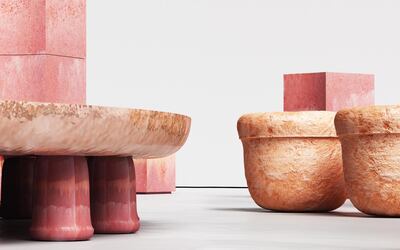The prestigious Abwab exhibition at Dubai Design Week typically features several pavilions from countries in the Middle East, North Africa and South Asia, offering an insight into the region's rich design scene.
This year, however, just one pavilion was commissioned, with the job falling to Iraqi designer Hozan Zangana, who created the work Fata Morgana entirely under quarantine conditions.
Naturally, the pandemic defined the piece he ultimately produced. Fata Morgana is an open-plan arrangement of seating components around a central origin point. The installation is meant to represent the framework of a modern-day city, in that it acknowledges the necessity for social interaction, albeit in a way that adapts to today's requirement for physical distancing. Its seven pillars, meanwhile, represent the UAE's seven emirates, and its construction is inspired by Middle Eastern techniques.
Here, Zangana explains more about the concept.
What did it mean to be awarded the 2020 Abwab Pavilion commission?
It was an honour, and an experience shared with an amazing team at Generous Studio and Woodcast Design. To have finished the Fata Morgana installation in its intended place at Dubai Design District, and see people experience it for the first time, made the long hours and hard work worth it.
Much of 'Fata Morgana' was created under lockdown conditions. How did this affect the work?
The pandemic has been a challenging time for everybody in the world. In the early days, it was clear that a lack of interaction would have a great impact on society. The concept aims to amplify the necessity of crossing each other's paths by presenting a pivotal intersection, demanding interaction between people and reactivating the connection with each other on a social level in a safe environment.
Tell us more about the historical Middle Eastern construction techniques used for ‘Fata Morgana’ ...
It was important to us that Fata Morgana would be relevant both in its location and for its time. The rammed earth technique [whereby materials such as gravel, sand, silt and clay are forced in between panels] was used to build the different elements of the pavilion and symbolises the earth, which is the foundation of culture and heritage.
The installation, with its different height levels, can be seen as a skyline with the seven pillars [for each emirate] in the middle and the smaller ones around them. The table and circular seating is inspired by the traditional way people meet and come together.
What are you looking forward to seeing during this year’s Dubai Design Week?
It's always an exciting time to meet new artists and find new voices that inspire. I'm looking forward to seeing some of the beautiful works from local designers, especially the works at Tashkeel, because this is the new generation of designers. I admire the work Lateefa bint Maktoum [founder of Tashkeel] is doing for the design community. She is someone who –within our culture – is investing her time and energy to protect beauty and heritage.
What are you working on next?
My next project will be revisiting one I had started before the pandemic, which would have been featured during Milan Design Week. Unfortunately, because of the pandemic, plans changed. In the new year, I hope to complete and show the installation Arbela: A Visual Guide in collaboration with Generous Studio. It will be an interactive experience including projection mapping, interactive soundscapes and a short film. Before a physical exhibition, we plan to launch the short film and a virtual reality event.
Dubai Design Week 2020 is on until Saturday, November 14; dubaidesignweek.ae






